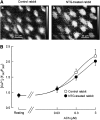Reduced hyperpolarization in endothelial cells of rabbit aortic valve following chronic nitroglycerine administration
- PMID: 16056232
- PMCID: PMC1751179
- DOI: 10.1038/sj.bjp.0706363
Reduced hyperpolarization in endothelial cells of rabbit aortic valve following chronic nitroglycerine administration
Abstract
This study was undertaken to determine whether long-term in vivo administration of nitroglycerine (NTG) downregulates the hyperpolarization induced by acetylcholine (ACh) in aortic valve endothelial cells (AVECs) of the rabbit and, if so, whether antioxidant agents can normalize this downregulated hyperpolarization. ACh (0.03-3 microM) induced a hyperpolarization through activations of both apamin- and charybdotoxin-sensitive Ca2+-activated K+ channels (K(Ca)) in rabbit AVECs. The intermediate-conductance K(Ca) channel (IK(Ca)) activator 1-ethyl-2-benzimidazolinone (1-EBIO, 0.3 mM) induced a hyperpolarization of the same magnitude as ACh (3 microM). The ACh-induced hyperpolarization was significantly weaker, although the ACh-induced [Ca2+]i increase was unchanged, in NTG-treated rabbits (versus NTG-untreated control rabbits). The hyperpolarization induced by 1-EBIO was also weaker in NTG-treated rabbits. The reduced ACh-induced hyperpolarization seen in NTG-treated rabbits was not modified by in vitro application of the superoxide scavengers Mn-TBAP, tiron or ascorbate, but it was normalized when ascorbate was coadministered with NTG in vivo. Superoxide production within the endothelial cell (estimated by ethidium fluorescence) was increased in NTG-treated rabbits and this increased production was normalized by in vivo coadministration of ascorbate with the NTG. It is suggested that long-term in vivo administration of NTG downregulates the ACh-induced hyperpolarization in rabbit AVECs, possibly through chronic actions mediated by superoxide.
Figures





Comment in
-
Reduced vascular reactivity after chronic nitroglycerine administration: EDHF mechanism is also downregulated.Br J Pharmacol. 2005 Oct;146(4):479-80. doi: 10.1038/sj.bjp.0706364. Br J Pharmacol. 2005. PMID: 16056231 Free PMC article. No abstract available.
Similar articles
-
Reduced vascular reactivity after chronic nitroglycerine administration: EDHF mechanism is also downregulated.Br J Pharmacol. 2005 Oct;146(4):479-80. doi: 10.1038/sj.bjp.0706364. Br J Pharmacol. 2005. PMID: 16056231 Free PMC article. No abstract available.
-
Characteristics of attenuated endothelium-dependent relaxation seen in rabbit intrapulmonary vein following chronic nitroglycerine administration.Br J Pharmacol. 2005 May;145(2):193-202. doi: 10.1038/sj.bjp.0706178. Br J Pharmacol. 2005. PMID: 15753949 Free PMC article.
-
Acetylcholine-induced membrane potential changes in endothelial cells of rabbit aortic valve.Br J Pharmacol. 1999 Jan;126(1):19-26. doi: 10.1038/sj.bjp.0702262. Br J Pharmacol. 1999. PMID: 10051116 Free PMC article.
-
Chronic nitroglycerine administration reduces endothelial nitric oxide production in rabbit mesenteric resistance artery.Br J Pharmacol. 2005 Oct;146(4):534-42. doi: 10.1038/sj.bjp.0706365. Br J Pharmacol. 2005. PMID: 16056230 Free PMC article.
-
Effects of increased intracellular Cl- concentration on membrane responses to acetylcholine in the isolated endothelium of guinea pig mesenteric arteries.J Physiol Sci. 2007 Feb;57(1):31-41. doi: 10.2170/physiolsci.RP012606. Epub 2006 Dec 28. J Physiol Sci. 2007. PMID: 17190590
Cited by
-
Diet-induced obesity impairs endothelium-derived hyperpolarization via altered potassium channel signaling mechanisms.PLoS One. 2011 Jan 21;6(1):e16423. doi: 10.1371/journal.pone.0016423. PLoS One. 2011. PMID: 21283658 Free PMC article.
-
Uremic Toxins and Vascular Dysfunction.Toxins (Basel). 2020 Jun 18;12(6):404. doi: 10.3390/toxins12060404. Toxins (Basel). 2020. PMID: 32570781 Free PMC article. Review.
-
Hypertension in chronic kidney disease: What lies behind the scene.Front Pharmacol. 2022 Oct 11;13:949260. doi: 10.3389/fphar.2022.949260. eCollection 2022. Front Pharmacol. 2022. PMID: 36304157 Free PMC article. Review.
-
Reduced vascular reactivity after chronic nitroglycerine administration: EDHF mechanism is also downregulated.Br J Pharmacol. 2005 Oct;146(4):479-80. doi: 10.1038/sj.bjp.0706364. Br J Pharmacol. 2005. PMID: 16056231 Free PMC article. No abstract available.
-
Characteristics of ACh-induced hyperpolarization and relaxation in rabbit jugular vein.Br J Pharmacol. 2012 Oct;167(3):682-96. doi: 10.1111/j.1476-5381.2012.02038.x. Br J Pharmacol. 2012. PMID: 22595036 Free PMC article.
References
-
- BÉNY J. Electrical coupling between smooth muscle cells and endothelial cells in pig coronary arteries. Pflügers Arch. 1997;433:364–367. - PubMed
-
- BÉNY J., PACICCA C. Bidirectional electrical communication between smooth muscle and endothelial cells in the pig coronary artery. Am. J. Physiol. 1994;266:H1465–H1472. - PubMed
-
- BERKENBOOM G., FONTAINE D., UNGER P., BALDASSARRE S., PREUMONT N., FONTAINE J. Absence of nitrate tolerance after long-term treatment with ramipril: an endothelium-dependent mechanism. J. Cardiovasc. Pharmacol. 1999;34:547–553. - PubMed
-
- BRAKEMEIER S., EICHLER I., KNORR A., FASSHEBER T., KOHLER R., HOYER J. Modulation of Ca2+-activated K+ channel in renal artery endothelium in situ by nitric oxide and reactive oxygen species. Kidney Int. 2003;64:199–207. - PubMed
-
- BRUNET P., BÉNY J. Substance P and bradykinin hyperpolarize pig coronary artery endothelial cells in primary culture. Blood Vessels. 1989;26:228–234. - PubMed
Publication types
MeSH terms
Substances
LinkOut - more resources
Full Text Sources
Miscellaneous

